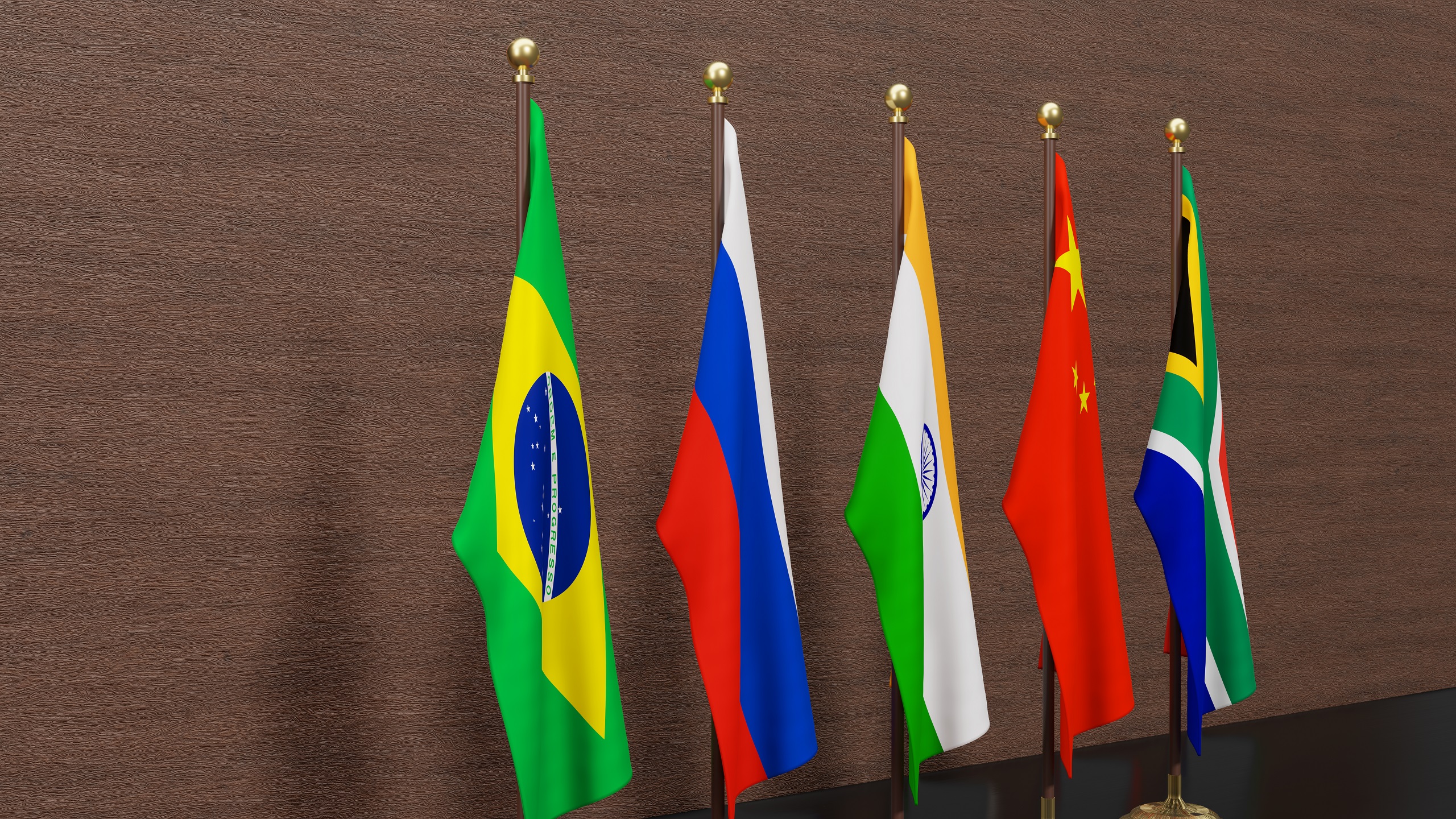Trump’s Tariff Response to Potential BRICS Currency ‘More Appearance Than Substance,’ Experts Say
Trump has threatened to slap 100% tariffs on BRICS nations if they move forward with a common currency, but experts say that the launch of such a currency is implausible due to logistical hurdles and disagreements within the bloc
President-elect Donald Trump has issued a stark ultimatum to countries within the BRICS alliance, a coalition of emerging economies led by China and Russia. Trump announced that his administration would impose 100% tariffs on countries within the alliance if they proceed with the planned creation of a new currency meant to challenge the US dollar’s dominance.
“The idea that the BRICS Countries are trying to move away from the Dollar while we stand by and watch is OVER,” Trump posted on Truth Social network on Saturday. “We require a commitment from these Countries that they will neither create a new BRICS Currency nor back any other Currency to replace the mighty US Dollar, or they will face 100% Tariffs, and should expect to say goodbye to selling into the wonderful US economy.”
Brazil, Russia, India, and China founded the BRIC organization in 2009. One year later, it added South Africa and rebranded as BRICS. In January 2024, Iran, Saudi Arabia, the United Arab Emirates, Ethiopia, and Egypt joined the alliance.
Members of the group have shared plans to reduce reliance on the US dollar, with Brazilian President Luiz Inácio Lula da Silva advocating for a common South American currency earlier this year. At the annual BRICS summit in August, Lula called on the coalition’s countries to create a common currency. Leaders of other BRICS nations mostly dismissed the idea, while critics in the US and Europe noted that such a plan could allow member states like Russia, China, and Iran to bypass Western sanctions.
Jeffrey Frankel, an international macroeconomist at Harvard and former economic adviser to President Bill Clinton told The Media Line that BRICS is unable to establish a common currency due to political disunity and a lack of economic integration among member countries.
There isn’t the ghost of a chance that the BRICS countries will create a common currency, regardless of what Trump says or does.
“There isn’t the ghost of a chance that the BRICS countries will create a common currency, regardless of what Trump says or does,” he said.
China, Russia, India, and Iran are all members of the Shanghai Cooperation Organization (SCO), another regional alliance that has proposed creating a shared currency. Alexey Maslov, an expert on socioeconomic and political dynamics within the SCO, described Trump’s proposed tariffs against BRICS nations as out of touch with the current global economic landscape.
Trump may not be fully aware of the nuances regarding the so-called BRICS joint currency. The recent BRICS forum highlighted many challenges in this area, and no one is seriously striving for a joint currency in the direct sense of the term.
“Trump may not be fully aware of the nuances regarding the so-called BRICS joint currency,” Maslov told The Media Line. “The recent BRICS forum highlighted many challenges in this area, and no one is seriously striving for a joint currency in the direct sense of the term.”
He noted that the discussion currently revolves around creating mechanisms for financial settlements among the nations rather than a unified currency.
Maslov said that the emergence of alternative currencies and payment mechanisms is inevitable, regardless of US opposition. “This is not just about BRICS,” he said. “SCO nations and individual countries are also advocating for alternative systems. For example, China is actively pushing its digital yuan as a medium of payment, and many nations see the need to rely more on international borrowing tools.”
This holiday season, give to:
Truth and understanding
The Media Line's intrepid correspondents are in Israel, Gaza, Lebanon, Syria and Pakistan providing first-person reporting.
They all said they cover it.
We see it.
We report with just one agenda: the truth.


The US acted destructively toward many countries, particularly Russia, by blocking payments and turning the dollar into a weapon. Before that, it was Iran and North Korea, and now China finds itself under similar pressure. These countries see the need for alternatives as a direct response to these actions.
He argued that the motivation for these shifts lies in the US’s “weaponization” of the dollar. “The US acted destructively toward many countries, particularly Russia, by blocking payments and turning the dollar into a weapon. Before that, it was Iran and North Korea, and now China finds itself under similar pressure. These countries see the need for alternatives as a direct response to these actions,” he said.
Trump’s hard-line stance sets the stage for heightened tensions between BRICS nations and the US, underscoring the geopolitical tug-of-war over economic influence and the future of global currencies.
Commenting on Trump’s proposed tariffs against BRICS nations, Frankel questioned both the feasibility and potential consequences of such threats. “I don’t know how much Trump as president will try to follow through on all the things he has talked about, nor to what extent his tariffs will be an effective tool in international relations. But this threat against BRICS is so far-fetched that, if it were to have any effect at all, it would probably be to undermine the credibility of other threats that he makes,” he said.
Russian economic commentator Tatiana Rybakova described the idea of a common BRICS currency as a long-standing but largely impractical proposal that has gained renewed attention due to Russian President Vladimir Putin’s push for a financial system not tied to the dollar.
She noted that a BRICS currency has been discussed for over a decade. The organization established its multilateral development bank in 2015, but “no substantial progress has been made,” Rybakova told The Media Line. “Consultations, if any, have been minimal and poorly publicized.”
Rybakova said Russia would gain the most from a joint currency because of the challenges caused by US sanctions and the dominance of the US dollar in global transactions.
Most BRICS countries don’t have much interest in a joint currency. It’s not a necessity for them. They are open to trading with Russia, but a closed BRICS currency would likely only serve within the bloc itself, and even then, trade imbalances pose problems. For example, Russia holds significant amounts of Indian rupees that it cannot effectively use. Trade between BRICS nations is still relatively weak, and such a currency wouldn’t solve these structural issues.
“Most BRICS countries don’t have much interest in a joint currency. It’s not a necessity for them,” she explained. “They are open to trading with Russia, but a closed BRICS currency would likely only serve within the bloc itself, and even then, trade imbalances pose problems. For example, Russia holds significant amounts of Indian rupees that it cannot effectively use. Trade between BRICS nations is still relatively weak, and such a currency wouldn’t solve these structural issues.”
While BRICS countries may symbolically support the idea of challenging Western dominance, Rybakova said there is no serious intent to create a currency to rival the US dollar.
Maslov called Trump’s threat of 100% tariffs on nations adopting alternative currencies unrealistic and counterproductive. “If Trump were to follow through, a significant part of Asia and Eurasia would fall under these measures, leaving the US with few trading partners. It raises the question of how the US plans to navigate such a situation,” he said.
The threat of 100% tariffs reveals Trump’s belief that the global economy can be controlled by orders rather than through adaptation to natural developments, Maslov added, describing such a mindset as “outdated.” “These are superficial attempts to regulate a world that is undergoing profound changes in priorities and power structures. In reality, the US will have to negotiate rather than confront,” he said.
It’s like telling a child not to eat oatmeal they already dislike.
Rybakova called the threat “a classic PR move.” “It’s like telling a child not to eat oatmeal they already dislike,” she said.
She said the statement was meant to make headlines and not address any real threat. “Russia is likely to respond with similar PR rhetoric, such as declaring that it won’t bow to Western imperialists or emphasizing its strength against global pressures,” she said. “It’s an exchange of statements, with little practical outcome behind it.”
While Russia is urgently exploring alternative payment systems to those tied to the US dollar—ranging from the digital ruble to cryptocurrencies—Rybakova said each approach comes with significant challenges.
Cryptocurrencies, while theoretically useful, are highly transparent, allowing transactions to be traced.
“Cryptocurrencies, while theoretically useful, are highly transparent, allowing transactions to be traced,” she said, adding that existing cryptocurrencies tied to reference assets, known as stablecoins, “are backed by private entities that are not immune to US pressure.”
Rybakova said that a gold-backed digital ruble might be a more feasible solution, given Russia’s substantial gold reserves, but that plan has its limitations. “Gold would need to be stored outside Russia to ensure credibility, but the logistics of transporting and managing it introduce additional complications,” she said.
Russia will continue to search for an alternative to dollar dominance, but most potential solutions are not yet practical, Rybakova said. “The reality is that BRICS countries support the idea rhetorically but lack the economic or political alignment to make it a reality,” she said. “For now, these statements remain more about appearances than substance.”

